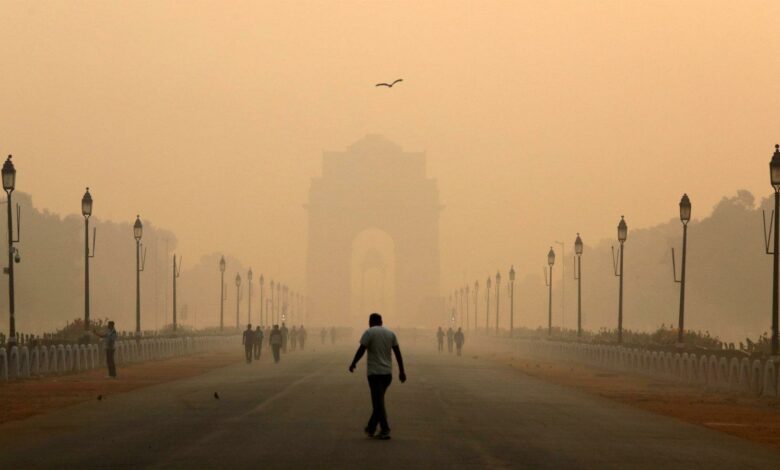Will Celebrating The International Day Of Clean Air For Blue Skies Be Active Agents For Our Planet’s Future To Save It From Pollution, Or Will We Remain, Silent Onlookers, While Pollution Writes A Terrible Ending?
According to a World Health Organisation factsheet issued in 2023, lung cancer killed 10 million lives worldwide in 2020, according to global health data. According to the Indian National Institute of Health's publication, 'Mapping of global, regional, and national incidence, mortality, and death-to-incidence ratio of lung cancer in 2020 and 2050,' this figure might rise by another 3.2 million by 2050.

Today, when the electricity went off, I recall my school days when our fans used to shut down, and our teacher then explained those intense heat waves with the notion of ‘Global warming’. However, as times moved on, it seems that, like any other aspect of pollution and climate change, this ‘Global warming’ also upgraded its version, and now it has taken the face of ‘GLOBAL BOILING’.
According to UN Secretary-General António Guterres, our mother Earth has debuted the era of global boiling. Scorching heatwaves, devastating floods and unpredictable weather patterns are stark reminders of an urgent demand to address the triple-planetary emergency of biodiversity loss, climate change and pollution.

The globe is not just tussling with climate change but also with another silent assassin— air pollution.
A new study has demonstrated the startling impact of fine particulate air pollution (PM2.5) on Indians’ life expectancy. On one hand, India is one of the countries with the youngest population; on the other, the average Indian’s life expectancy is cut by 5.3 years due to air pollution.
In Delhi, a city infamous for its severe pollution, which is now gearing up for the greatest event of the year, the G20 summit; this reduction could be as high as 11.9 years compared to the World Health Organisation standard of 5 µg/m3 (micrograms per cubic meter). Worryingly, figures show that if India fails to satisfy its national ambient air quality criteria (40 µg/m3), an average Indian might lose 1.8 years of life expectancy, while a resident of Delhi could lose up to 8.5 years.
The study emphasises the crucial need for improved air quality across the country. It also discovered that 67.4 per cent of the country’s population lives in places where air quality exceeds the country’s own official threshold of μg/m3. Even in the least polluted district in the region, Pathankot in Punjab, particulate pollution is more than seven times the WHO guideline, reducing life expectancy by 3.1 years if current levels continue.

According to a World Health Organisation factsheet issued in 2023, lung cancer killed 10 million lives worldwide in 2020, according to global health data. According to the Indian National Institute of Health’s publication, ‘Mapping of global, regional, and national incidence, mortality, and death-to-incidence ratio of lung cancer in 2020 and 2050,’ this figure might rise by another 3.2 million by 2050. This is unfortunate as, on the one hand, science is unleashing new ways to fight cancer, and on the other, the causes of cancer are increasing at an alarming rate.
Some cases of viable solutions-The gleam with hope.
Clean air policies differ depending on the circumstance. There is no one-size-fits-all answer to improve air quality; several solutions from many sectors are required. However, we can and must all take action. Following are some of the efforts done by different nations towards mitigating the efforts of air pollution. Also, there are many other practices that can be studied to analyse which works better for certain regions.
Cities throughout the world that prioritise human health and environmental sustainability include Ljubljana (Slovenia), Accra (Ghana), Seville (Spain), Bogota (Colombia), and Medellin (Colombia). Car-free zones, green spaces, smart urban designs, electric public transit, nature-based solutions, and cutting-edge biotechnology all provide good benefits.
China is the world’s greatest producer of greenhouse gases and is home to several of the world’s most polluted cities. The Jing-Jin-Ji Programme for Innovative Financing for Air Pollution Control was China’s first operation to apply the Programme for Result (PforR) instrument in the energy sector. The programme was created to aid in the implementation of the government’s Air Pollution Control Action Plan and the 13th Five-Year Plan (2016-2020) for energy efficiency & clean energy, with a focus on reducing air pollutants at their source through improved energy efficiency and the expansion of clean energy.
Indonesia has promised to pursue low-carbon development in an effort to contribute to the global effort of limiting the increase in world average temperatures to 2 degrees Celsius by the half of the century. The region agreed unequivocally in its Intended Nationally Determined Contribution (INDC) to decrease its emissions to 29% below business-as-usual levels by 2030. With foreign assistance, this decrease might reach 42% (conditional pledge).
The burning of straw waste is a frequent practice in many Asian nations, leading to air pollution. Last December 13-15, 2022, IRRI mechanisation and postharvest specialists offered a sustainable rice straw management course in Thailand. According to programme officials, finding an alternative to burning rice straw decreases emissions and greatly reduces air pollution, which is a key priority for Thailand, and thus provides revenue to farmers by selling the rice straw. They see this as an excellent chance for everyone to collaborate and contribute to Thailand’s transition to carbon neutrality.

The complementary efforts- The spread of awareness.
The World Air Quality Project uses real-time Air Quality data to help citizens make educated decisions. Environmentally aware practises, such as digital working, have been adopted in partnership with UNEP through the ‘Virtual Meetings’ initiative. Clean-Air-For-Schools is educating everyone about the importance of clean air.
Other commendable activities include the transition to electric vehicles, the replacement of lighting systems with greener LED arrangements, the implementation of solar-powered offices, the preservation of historical sites through the development of air pollution reduction strategies, and the implementation of effective green solutions (urban forests, parks, and green corridors).
Conclusion.
Just on September 7, we marked International Day of Clean Air for Blue Skies. Nonetheless, clean air is still a long way off in many megacities and other areas. We expect that a coordinated effort to systematically improve air quality, especially in Delhi, would be prioritised. People caused the problem. Thus, it should be people who identify and implement remedies aided by imaginative, sufficient air quality regulations and action plans. As we inhale the repercussions of our actions, the ultimate dilemma beckons: Shall we be the torchbearers of change for our planet’s future, or will we be mute bystanders who let pollution write a sad ending?




